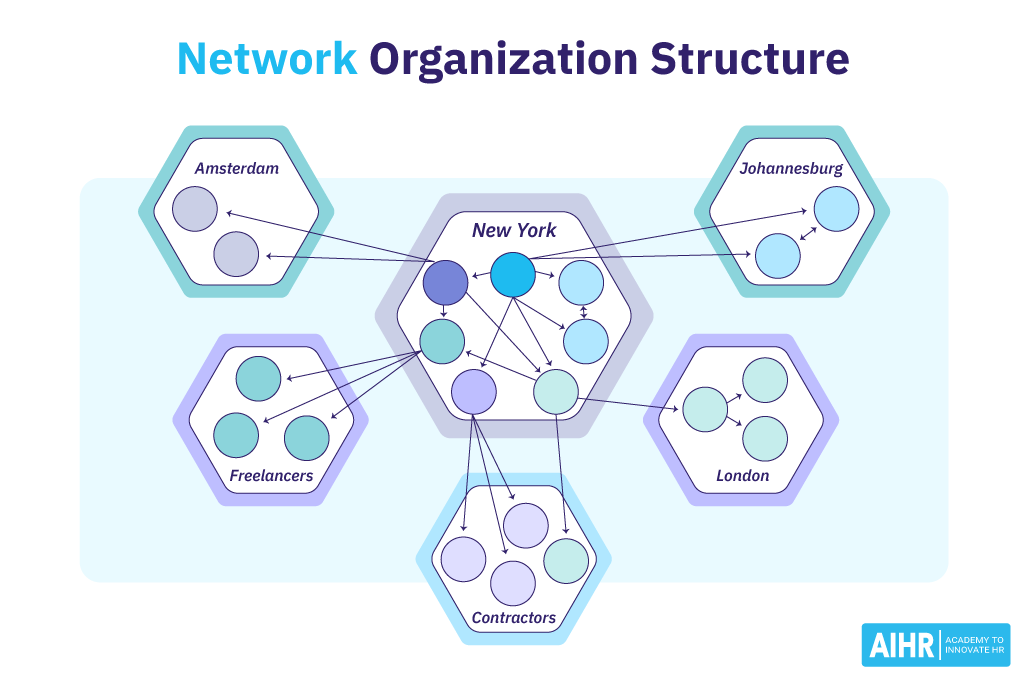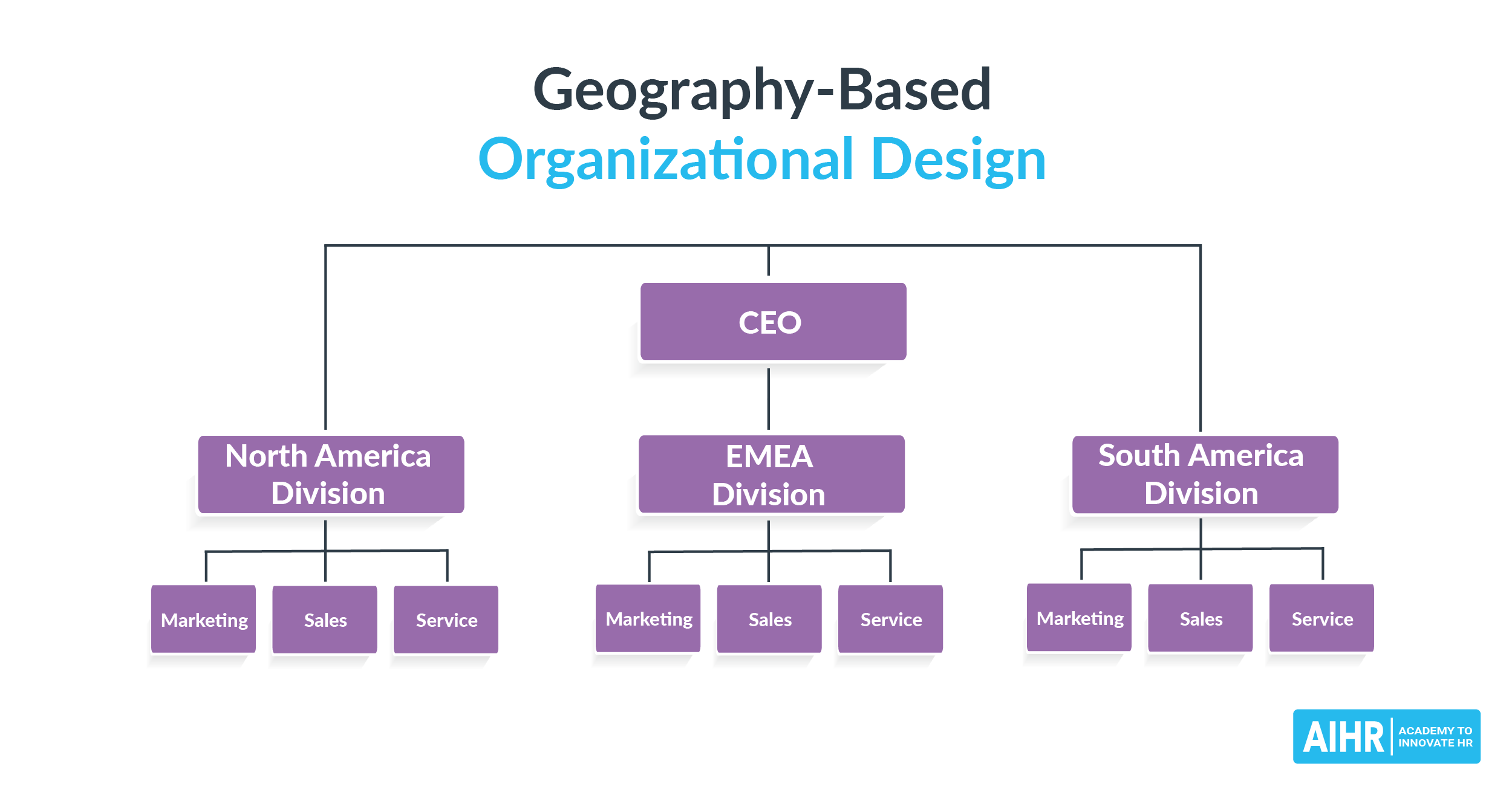Hybrid Organizational Structure
What is a hybrid organizational structure?
A hybrid organizational structure is a business model that incorporates elements from different traditional organizational structures, typically combining aspects of both functional and divisional arrangements.
The exact structure of a hybrid organization can vary significantly based on an organization’s priorities and needs.
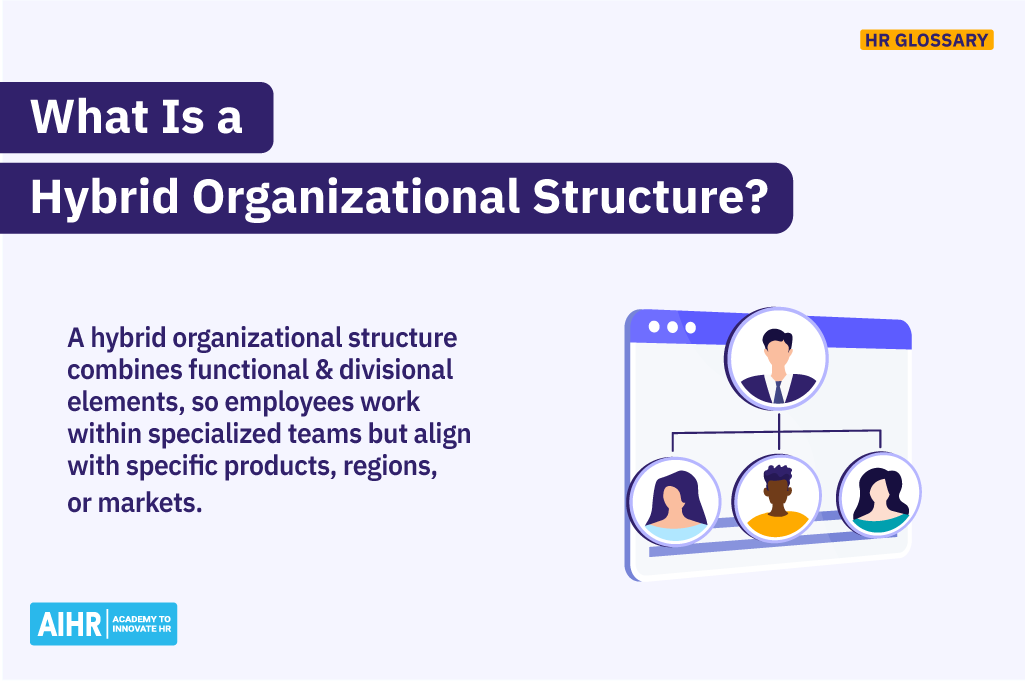
What are the key characteristics of a hybrid organization?
Some of the most significant characteristics of a hybrid structure include:
- Versatility: Hybrid organizations can adapt their structure according to changing business priorities and strategies. This allows them to optimize operations across different functions and divisions simultaneously.
- Decentralized decision-making: By incorporating elements of divisional structures, hybrid organizations often enable more localized or division-specific decision-making.
- Centralized oversight: While they may allow for decentralization in some areas, hybrid organizations also retain centralized control where it’s crucial, such as in strategic planning and resource allocation.
- Collaboration across units: Hybrid structures often encourage a culture of collaboration and teamwork to manage the interdependencies between different parts of the organization.
Hybrid organizational structure example
FlavorFusion is a mid-sized beverage and bakery goods company that creates unique taste experiences by fusing traditional and modern flavors. It employs approximately 300 people, based in its Chicago headquarters and regional offices throughout North America, Latin America, the Caribbean, Europe, and Central Asia.
FlavorFusion employs a hybrid organizational structure, merging functional management with geographic divisions. Its structure looks like this:
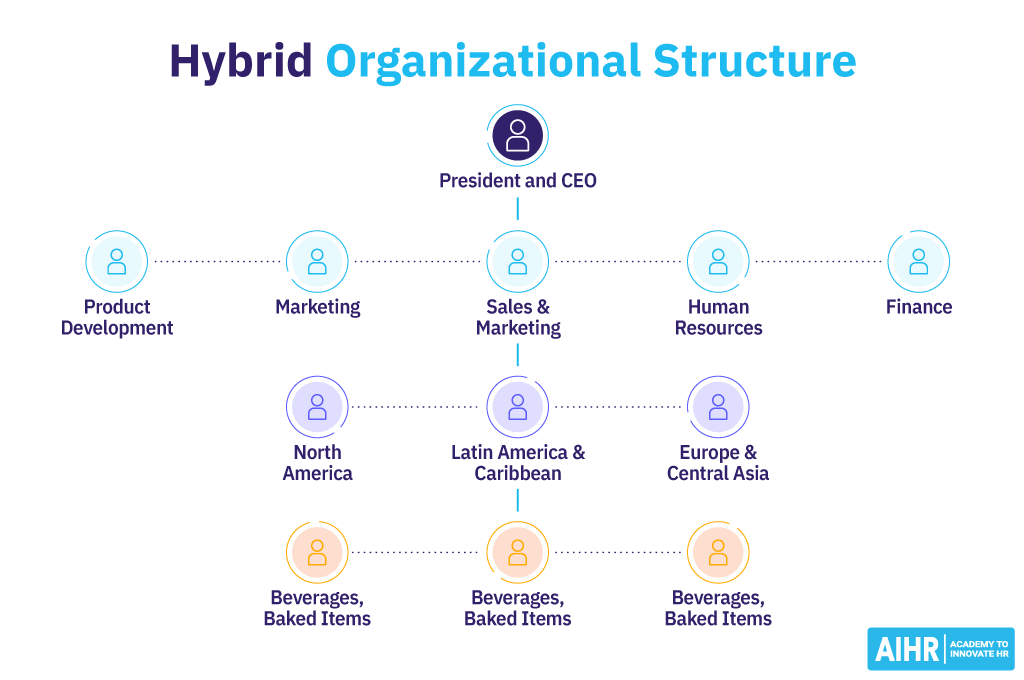
Hybrid organizational structure: Advantages and disadvantages
Benefits
- Flexibility and adaptability: A hybrid structure allows organizations to be more adaptable to market or industry changes. Not being strictly bound to a single organizational model allows them to adjust their approach as needed to address new challenges or opportunities.
- Scalability: This structure can be more scalable than purely functional or divisional structures. It allows for growth in specific areas without disrupting the whole organization’s structure.
- Optimized resource allocation: This structure enables more efficient resource use by allowing the dynamic assignment of personnel and assets where they’re most needed. Teams can be formed and disbanded as projects require, ensuring resources are not underutilized.
- Better customer focus: A hybrid structure can enable organizations to align more closely with customer needs. For instance, companies can maintain specialized teams focused on specific customer segments or product lines, ensuring efforts are directly tied to improving customer experience and value.
Limitations
- Complexity in management: Managing a hybrid structure can be challenging due to the varied forms of governance and coordination mechanisms needed across different divisions and functional areas.
- Conflicting priorities: Different segments of the organization may have conflicting priorities, which can make aligning overall corporate objectives difficult. For instance, a division focused on product innovation might conflict with a function focused on cost reduction.
- Risk of ambiguity: Due to its multifaceted nature, it can be difficult to pinpoint responsibility and accountability in a hybrid structure. This ambiguity can affect performance evaluations and management effectiveness.
- Difficulties in performance measurement: Measuring performance can be more complicated in a hybrid structure due to the diverse and overlapping areas of responsibility. Standardizing performance metrics that fairly reflect the contributions of different divisions and functional areas requires careful planning and implementation.
Matrix vs. hybrid organizational structure
Here are the key differences between a hybrid and a matrix structure:
Definition
Combines elements of functional and divisional structures, often creating unique groupings based on needs.
Blends functional and project-based structures, where employees report to both functional and project managers.
Reporting lines
Typically, single reporting line within each division or function.
Dual reporting lines; employees report to multiple managers (e.g., project and functional managers).
Advantages
Highly adaptive and responsive to changes in environment or business strategy.
Facilitates resource sharing and interdisciplinary collaboration.
Disadvantages
Can be complex and require more management.
Can lead to conflicts due to dual authority and is generally costlier.
Ideal for
Organizations needing a blend of functional expertise and divisional autonomy.
Organizations managing multiple, overlapping projects requiring cross-functional collaboration.
Choosing between a hybrid and a matrix structure depends significantly on the organization’s size, industry, and specific challenges. Each has its strengths and weaknesses, and the best choice often depends on the organization’s specific operational needs and strategic goals.
HR tip
When installing a hybrid structure, creating a smooth transition between functional and divisional parties is crucial. This requires the use of technology and strategies to guarantee effective communication. All parties should feel empowered to use their skills and share their ideas when relevant.
Implementing a hybrid organizational structure: Tips for HR
A hybrid structure can seem overwhelming to implement, but any company can streamline the transition by following these tips:
- Clarify roles and responsibilities: Clearly define each role to prevent confusion and overlaps. This ensures team members know exactly who handles what, even when working across various channels.
- Set flexible policies: Hybrid models benefit from adaptable policies that allow for adjustments, fostering innovation and agility across departments. Encourage policies that support “think global, act local” practices to improve decision-making without rigid constraints.
- Train leaders on hybrid management skills: Hybrid team management requires specific skills, such as handling remote collaboration, fostering trust, and supporting employees across various setups. Make sure leaders are equipped to inspire and manage effectively, promoting transparent communication and participation.
- Establish effective communication channels: Strong communication is key. Use an ATAWAD (Anytime, Anywhere, Any Device) approach to ensure seamless and fast information flow and allow all team members to stay aligned and responsive.
- Plan for a smooth transition: Transitioning to a hybrid structure doesn’t happen overnight. Dedicate the necessary time and resources to a phased transition, supporting employees and teams through regular check-ins to address any challenges they may face while settling into the new structure.
- Invest in supporting technology: Hybrid setups often rely on tools for collaboration, data sharing, and real-time communication. Investing in technology aligns with the company’s goal to be agile and connected across all levels, ensuring consistency and facilitating faster collaboration between physical and digital teams.
Other types of organizational structures
There are other types of organizational structures besides the hybrid organizational structure. Let’s take a look at some of them:
1. Flat organizational structure
A flat organizational structure features fewer hierarchical levels, with more direct reporting lines between staff and executives. It is more common in startups and small businesses.
Companies like Buffer operate with a flat organizational structure, prioritizing minimal levels of hierarchy and encouraging broad spans of control.
- Advantages: Encourages more open communication and collaboration, faster decision-making, and innovation due to fewer bureaucratic hurdles.
- Disadvantages: Can lead to role ambiguity and conflict without clear lines of authority; may become challenging to maintain as the organization grows.
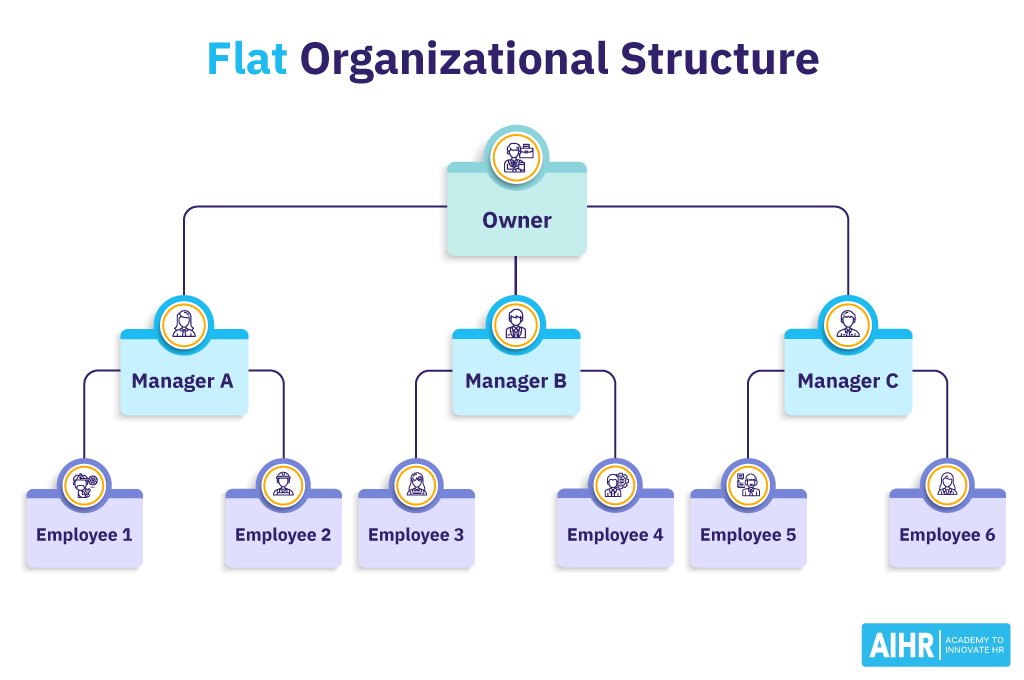
2. Functional organizational structure
A functional organizational structure divides organizations into departments based on function, such as finance, marketing, and human resources, each reporting to a central leadership.
Large corporations like Amazon often use functional structures to maintain efficiency in specialized areas.
- Advantages: Specialization and efficiency within functional departments, and easier management of specialized tasks.
- Disadvantages: Can create silos and reduce cross-functional communication; may lead to conflicts among departments with different priorities.
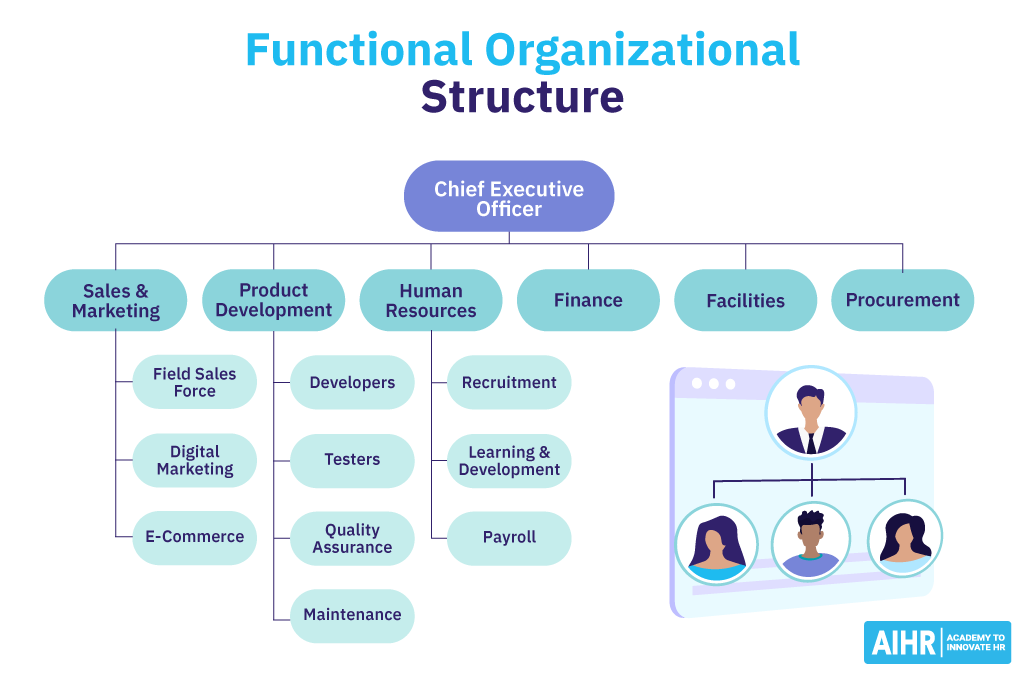
3. Divisional or product organizational structure
A divisional organizational structure organizes a company into divisions based on products, services, or geographic locations, with each of them functioning semi-autonomously. This structure is common in large corporations with diverse product lines or different markets.
Procter & Gamble operates with a divisional structure, focusing on product lines like beauty, healthcare, and family care.
- Advantages: Allows for flexibility and a focus on specific markets or products; facilitates quick response to market changes within each division.
- Disadvantages: Can lead to resource duplication across divisions; potentially weaker communication between divisions and central management.
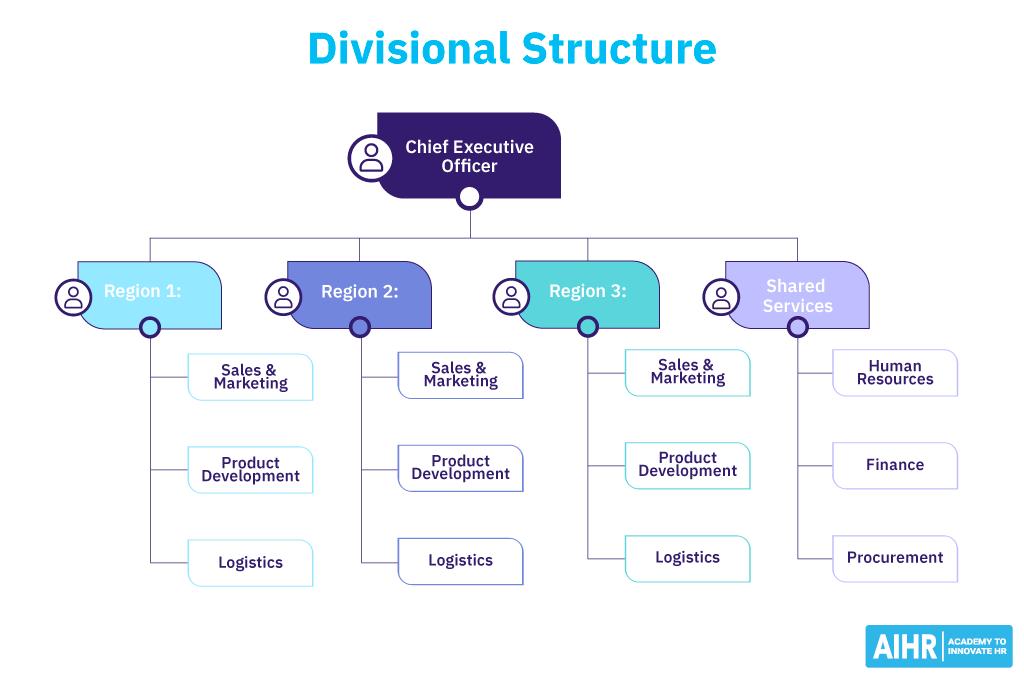
5. Network structure
A network structure emphasizes decentralized, flexible connections across an organization, leveraging digital tools for collaboration beyond traditional hierarchical lines.
Tech startups and companies in rapidly evolving industries often adopt this structure to stay agile and foster innovation.
- Advantages: Enables organizations to adapt quickly to changes; allows for dynamic resource allocation across projects and teams.
- Disadvantages: The lack of clear reporting lines can lead to ambiguity regarding responsibilities and decision-making authority; requires advanced communication capabilities to navigate the complex web of interactions and maintain coherence.
